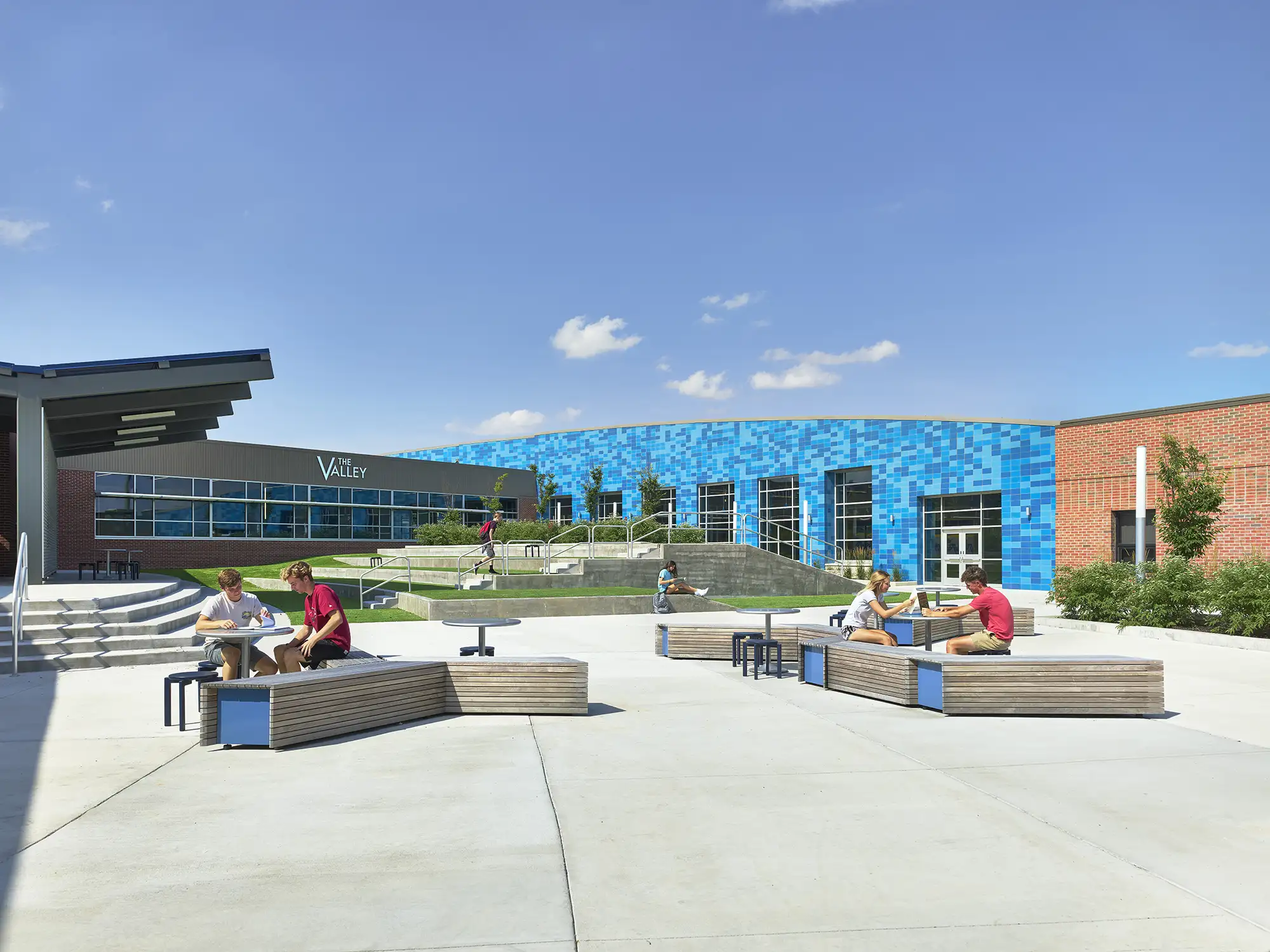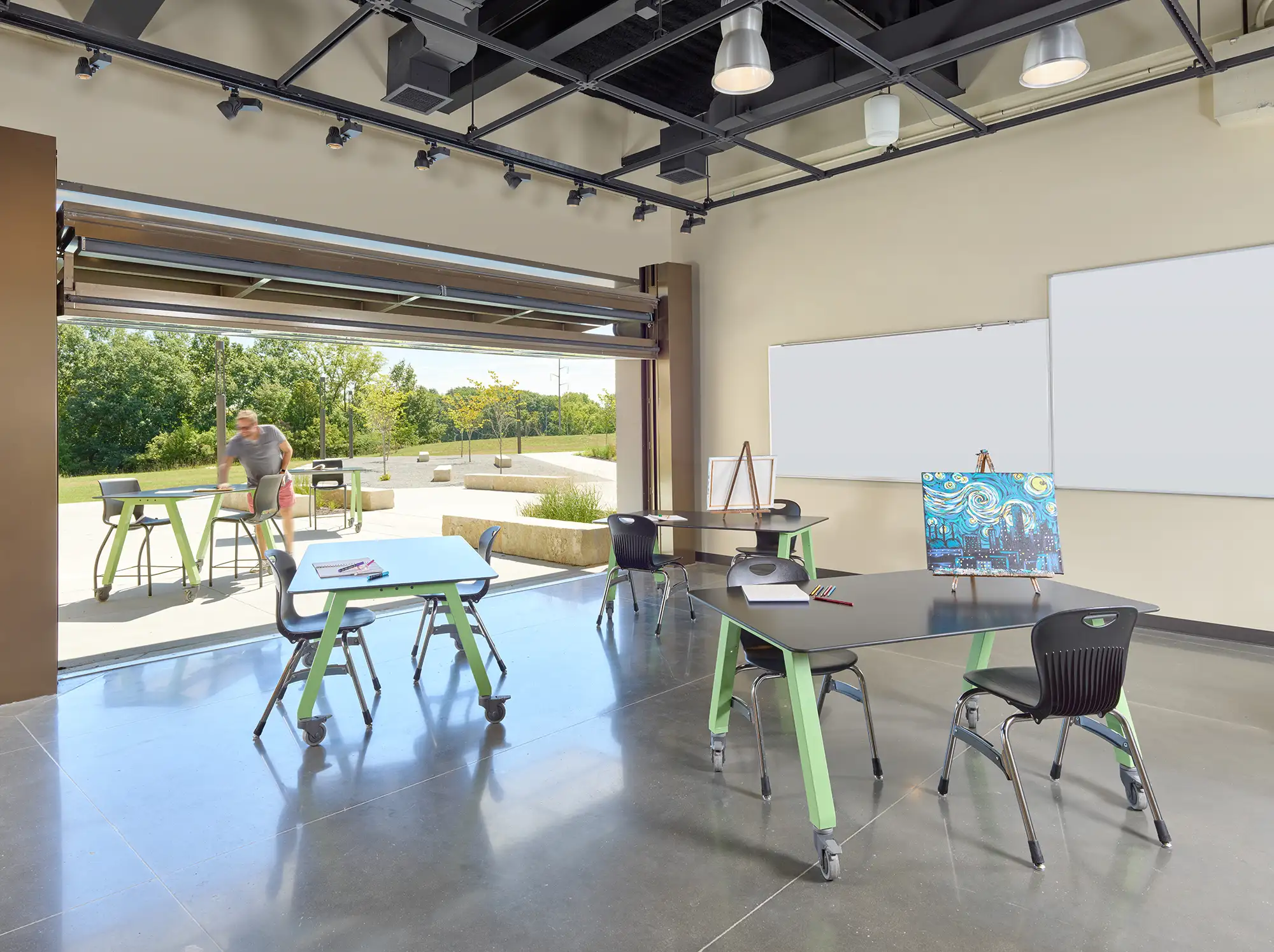Every building has a story. A water story, a safety story, an energy story… For us, these stories all intertwine with sustainability. We believe sustainable design is inseparable from great design.
So, what does sustainability mean when it comes to educational architecture? While we have known for some time of the risks of global warming, our communities are just now starting to feel the pressure and pain of the climate crisis effects, and we are all responsible to be part of the solution. A perception exists that sustainable design strategies can be tough for school administrators to adopt. Budget constraints, new building systems, and our general fear of change conspires to lock our communities into repeating past mistakes and settling for less than we can achieve. As a sustainability expert and creator of Hollis + Miller’s sustainable design standards, I’d like to discuss important considerations, starting with how we define sustainability.
Having specialized in educational architecture my entire career and leading many educational projects both large and small, I’ve learned to approach each project through the eyes of the community. Analyzing the quality of space from an administrator’s, facilitator’s or student’s standpoint has redefined sustainability as ever present and changing – not simply achieved in a singular moment.
 Through our co-creation process, HMA holds our preconceived design notions in check and believes in listening and learning from our clients first. This enables us to design with, not just for, the communities we serve. This continued cycle of listening and learning has organically established sustainable strategies integral to Hollis + Miller’s standards and practice long before Leadership in Energy and Environmental Design (LEED) packaged its requirements to do so.
Through our co-creation process, HMA holds our preconceived design notions in check and believes in listening and learning from our clients first. This enables us to design with, not just for, the communities we serve. This continued cycle of listening and learning has organically established sustainable strategies integral to Hollis + Miller’s standards and practice long before Leadership in Energy and Environmental Design (LEED) packaged its requirements to do so.
LEED is a prescriptive building rating system designed to illustrate sustainable qualities and to push the building industry’s capabilities. LEED has done a great job of moving the needle and bringing sustainable design opportunities to our market, but because it was designed to be overarching, it is not perfect for every project or community.
Sustainability is always part of the project—whether you plan it, certify it, or pay attention to it at all. All buildings start new, operate at peak functionality for a time, and then start to decay, however it is the degree to which the building can endure both in function, beauty, and operation for generations determining how sustainable it truly is.
We are a purpose-based firm intentionally choosing the educational market as our best chance to empower our communities andI was drawn to HMA for this very reason. Our educational building types must be viewed through the lens of generations – not just decades.
Should a district pursue LEED Certification? The answer will vary from community to community. Regardless of that decision, we know from our seven decades of experience our process and expertise will create the opportunity for the most sustainable outcome – solutions we refer to as Enduring Learning Environments.
 Going “green” is one of the first things coming to many people’s minds when they hear the word sustainability. But the latest trends or gadgets might not be the most sustainable option for your community.
Going “green” is one of the first things coming to many people’s minds when they hear the word sustainability. But the latest trends or gadgets might not be the most sustainable option for your community.
Truly sustainable design results in a building reinforcing the community’s values and how they will live. The value of understanding capabilities and intentions of how the buildings and campuses will be maintained and cared for cannot be understated.
Certain products can be deemed to be categorically sustainable, but if you’re replacing them in three years, they’re not a worthwhile, generational material. We strive to identify sustainable strategies aligning with the projected maintenance priorities to maximize the quality of the building today and for decades to come.
Breaking the budget to maximize something—like photovoltaic energy to achieve a net-zero—isn’t always worth it. Or, for instance, creating a landscape plan to appear “greener” could be on your list, however the plants, maintenance and various items not aligning with a district’s ability to maintain the landscape creates more waste, creates a bigger carbon footprint and could cause the district to lose money. This can cause a long-term ripple effect, whereas directly aligning sustainability with the most efficient way to operate can allow districts to maintain the best balance of both. If that balance takes us to a solution like net-zero, LEED Platinum, or Living Building challenge, we are all for it and can take you there. For our team, we focus on alignment and supporting our clients’ districts and communities instead of chasing the latest sustainability trends.
 In educational architecture, we focus on perfect solutions, not perfect buildings. Every solution must be tailored to the unique climate region, community values, and economy. At Hollis + Miller, we have learned a community will support what it believes in and this concept applies to the qualities of sustainability, as well. The more we can connect with the client and design proximate to all stakeholders in the community, the more ownership and engagement they will have in the final building. If the community is engaged, if they understand why design decisions were made, they will magnify the positive impact tenfold.
In educational architecture, we focus on perfect solutions, not perfect buildings. Every solution must be tailored to the unique climate region, community values, and economy. At Hollis + Miller, we have learned a community will support what it believes in and this concept applies to the qualities of sustainability, as well. The more we can connect with the client and design proximate to all stakeholders in the community, the more ownership and engagement they will have in the final building. If the community is engaged, if they understand why design decisions were made, they will magnify the positive impact tenfold.
For many, the tendency has been for design professionals, clients and communities to put sustainability next to the design, not integrated as a part of it. Educational architecture is about impacting tens of thousands of students at a time, as well as the communities around them. At Hollis + Miller our co-creation approach and desire to listen first and design second continues to feed an evolution of thought in sustainable design. To learn more about our sustainable approach and how we can help design your future, contact us today.
Ryan Walters, AIA, LEED AP is a Partner at Hollis + Miller Architects, an integrated architecture firm designing the future of learning environments, including higher education, public and private K-12. Share your thoughts on Facebook, LinkedIn or on Twitter @HollisandMiller.
Sign up to hear about the latest news from our architecture firms in Denver and Kansas City.
© 2024 – Hollis + Miller. All rights reserved.